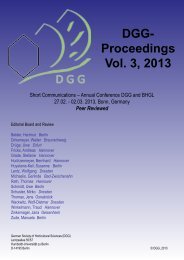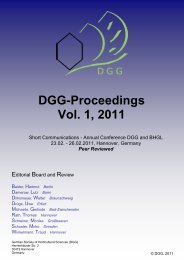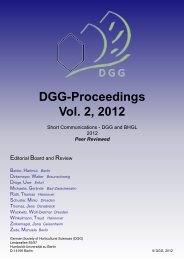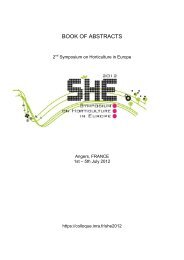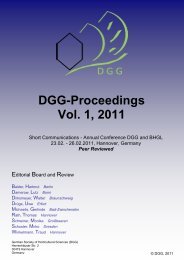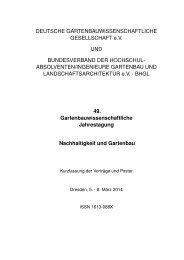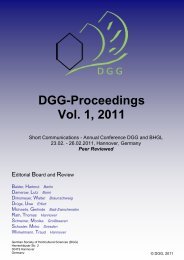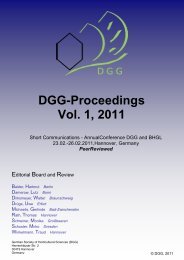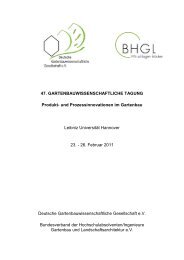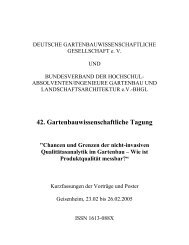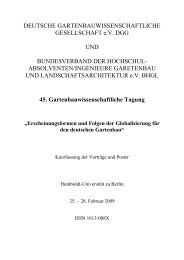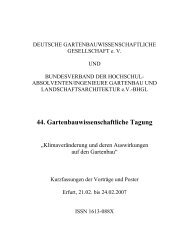43. Gartenbauwissenschaftliche Tagung - (DGG) und des
43. Gartenbauwissenschaftliche Tagung - (DGG) und des
43. Gartenbauwissenschaftliche Tagung - (DGG) und des
Erfolgreiche ePaper selbst erstellen
Machen Sie aus Ihren PDF Publikationen ein blätterbares Flipbook mit unserer einzigartigen Google optimierten e-Paper Software.
Gemüsebau<br />
Glucosinolates Content Level in Turnip (Brassica rapa L.) Influenced by<br />
Interaction of Nitrogen and Sulphur Supply<br />
S.M. Li 1, 3 , I. Schonhof 2 , A. Krumbein 2 , L. Li 3 , H. Stützel 4 and M. Schreiner 2<br />
1 3<br />
Department of Plant Nutrition, China Agricultural University, Beijing, China, Resource and<br />
Environment College, Northeast Agricultural University, Harbin, China<br />
lishumin113@yahoo.com.cn<br />
2<br />
Institute of Vegetable and Ornamental Crops, Großbeeren/Erfurt e. V., Germany,<br />
4 Institute of Vegetable and Fruit Sciences, University of Hannover, Germany<br />
The glucosinolates (GLS) are a large of nitrogen and sulphur containing compo<strong>und</strong>s which<br />
occur in all economically important of Brassica vegetables. Previous studies have shown that<br />
turnip had high content of health promoting GLS, such as indol GLS and gluconasturtiin. S<br />
supply generally is considered to be the most important factor for affecting the content of<br />
GLS, and S uptake is strongly suppressed by a large amount of N application. But little is<br />
known about the effect of ratio of nitrogen and sulphur on the regulation of the synthesis of<br />
GLS in turnip. Therefore, pot experiments were conducted to investigate different combinations<br />
of N and S applications on GLS content in turnip roots. The experiment consisted of 4<br />
levels of N application (80, 160, 240 and 320 kg N ha -1 donated by N80, N160, N240 and N320)<br />
and 3 levels of S application (10, 20, 60 kg S ha -1 donated by S10, S20 and S60). A modified<br />
HPLC method was used to determine <strong>des</strong>ulfo-glucosinolates content in roots. Significant influence<br />
of N and S application on total and profile of individual GLS was fo<strong>und</strong> in pot experiments.<br />
The total GLS content ranged widely from 14.4 to 108.0 mg 100 FW -1 . In each<br />
level of N treatment, total GLS content significantly increased by increasing S supply. With<br />
increasing N supply, total GLS content decreased in low S treatments. The indole GLS and<br />
gluconasturtiin content in turnip roots showed similar trends to the total GLS content. But in<br />
S10 and S20 treatments N supply had no significant influence on indole GLS content. S supply<br />
had no significant influence on N concentration in roots and leaves in each level of N treatment.<br />
In low S supply, S concentration in turnip roots decreased in response to high N supply.<br />
But in high S supply, S concentration in turnip roots increased in response to high N supply.<br />
There was good correlation between total GLS and N: S ratio in roots. Here results indicated<br />
that GLS content was strongly influence by N as well as S supply.<br />
BHGL – <strong>Tagung</strong>sband 24/2006<br />
197



